Python Django 實作(二) 爬蟲並分頁顯示資料
本次練習包含以下項目
- 安裝爬蟲需要用到的套件
- 建立專案
- 分析 json 資料並分頁顯示
- 分析網頁資料並分頁顯示
一、安裝爬蟲需要用到的套件:
1.安裝 BeatuifulSoup4 套件
2.安裝 requests 套件
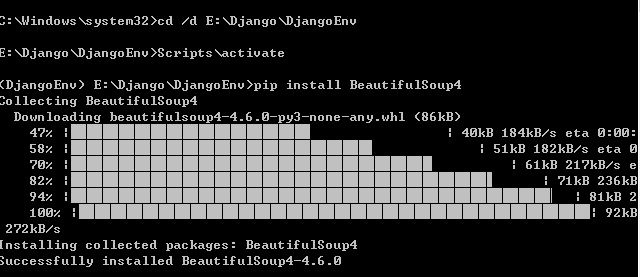
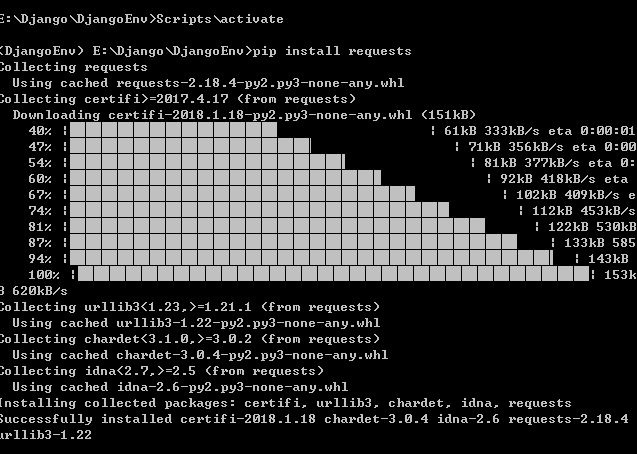
pip install BeatuifulSoup4
pip install requests
二、建立專案:
- 建立一個名為 crawler 的專案
- 建立名為 crawlerapp 的 App
- 建立 templates 目錄、static 目錄
- 建立makemigrations 資料檔,並利用 migrate 將模型與資料庫同步
- 完成<setting.py>的設定
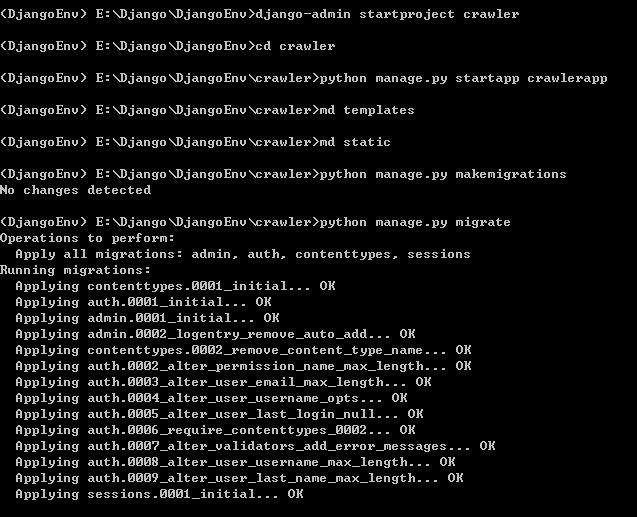
三、分析 json 資料並顯示:
這次使用的範例是政府開放資料平台的 動物認領養json
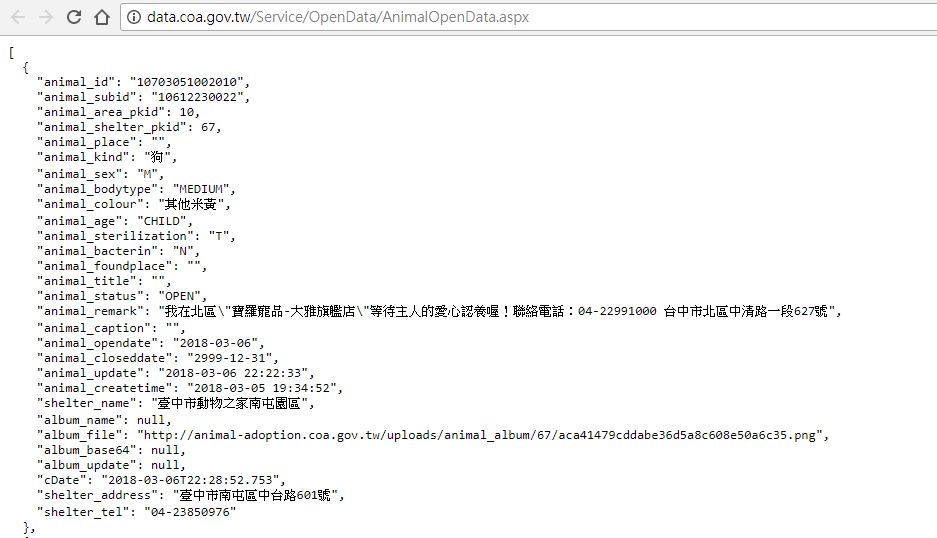
1.分析json
由於為了顯示單筆資料,所以會將元素加到串列中取用
接著將依照以下步驟進行:
- 導入分析需要用到的套件
- 連接網址
- 分析json
- 建立空串列
- 將元素添加入串列
import json
import requests
res = requests.get('http://data.coa.gov.tw/Service/OpenData/AnimalOpenData.aspx') #連接網址
ress = res.text
jd = json.loads(ress) #分析json
animal_place=[] #建立空串列
animal_kind=[]
animal_sex=[]
animal_bodytype=[]
animal_age=[]
album_file=[]
shelter_name=[]
shelter_address=[]
shelter_tel=[]
for item in jd: #將元素添加入串列
animal_place.append(item['animal_place'])
animal_kind.append(item['animal_kind'])
animal_sex.append(item['animal_sex'])
animal_bodytype.append(item['animal_bodytype'])
animal_age.append(item['animal_age'])
album_file.append(item['album_file'])
shelter_name.append(item['shelter_name'])
shelter_address.append(item['shelter_address'])
shelter_tel.append(item['shelter_tel'])
2.顯示單筆資料
在 <views.py> 中建立一個名為 crawler 的自訂函數
def crawler(request):
res = requests.get('http://data.coa.gov.tw/Service/OpenData/AnimalOpenData.aspx') #連接網址
ress = res.text
jd = json.loads(ress) #分析json
animal_place=[] #建立空串列
animal_kind=[]
animal_sex=[]
animal_bodytype=[]
animal_age=[]
album_file=[]
shelter_name=[]
shelter_address=[]
shelter_tel=[]
for item in jd: #將元素添加入串列
animal_place.append(item['animal_place'])
animal_kind.append(item['animal_kind'])
animal_sex.append(item['animal_sex'])
animal_bodytype.append(item['animal_bodytype'])
animal_age.append(item['animal_age'])
album_file.append(item['album_file'])
shelter_name.append(item['shelter_name'])
shelter_address.append(item['shelter_address'])
shelter_tel.append(item['shelter_tel'])
return render(request,"crawler.html",locals())
創建一個名為 <crawler.html> 的模版
這邊調用串列的第一筆資料(第0項)
但是這邊不同於python語法的 "串列[0]"
而要使用 "串列.0" 的方式來顯示資料
<!DOCTYPE html>
<html>
<head>
<meta charset="utf-8">
<title>顯示第一筆資料</title>
</head>
<body>
<h2>顯示 Django json單筆資料 </h2>
動物的實際所在地: {{animal_place.0}} <br />
動物的類型: {{animal_kind.0}} <br />
動物性別: {{animal_sex.0}} <br />
動物體型: {{animal_bodytype.0}} <br />
動物年紀: {{animal_age.0}} <br />
動物所屬收容所名稱: {{shelter_name.0}} <br />
圖片: <br />
<img src="{{album_file.0}}"> <br />
地址: {{shelter_address.0}} <br />
聯絡電話: {{shelter_tel.0}} <br />
</body>
</html>
在<urls.py>添加crawler的路徑,並到瀏覽器執行:
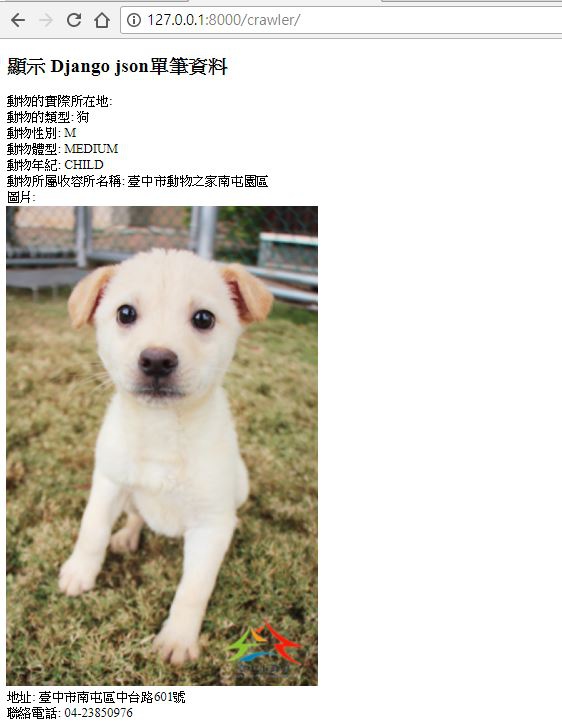
3.顯示多筆資料
在 <views.py> 中建立一個名為 crawlerall 的自訂函數
由於多筆資料可以直接使用for迴圈來顯示,因此不用將元素加入串列
def crawlerall(request):
res = requests.get('http://data.coa.gov.tw/Service/OpenData/AnimalOpenData.aspx')
ress = res.text
jd = json.loads(ress)
return render(request,"crawlerall.html",locals())
創建一個名為 <crawlerall.html> 的模版
<!DOCTYPE html>
<html>
<head>
<meta charset="utf-8">
<title>顯示所有資料</title>
</head>
<body>
<h2>顯示 json 所有資料</h2>
<table border="3" cellpadding="2" cellspacing="2">
<th>動物的實際所在地</th>
<th>動物的類型</th>
<th>動物性別</th>
<th>動物體型</th>
<th>動物年紀</th>
<th>圖片</th>
<th>動物所屬收容所名稱:</th>
<th>地址</th>
<th>連絡電話</th>
{% for i in jd %} <!-- #jd為json所有資料 i則是現在建立用來遞迴的變數 -->
<tr>
<td>{{i.animal_place}}</td> <!-- #Django Template 語言 使用'.' 來顯示子項目 -->
<td>{{i.animal_kind}}</td>
<td>{{i.animal_sex}}</td>
<td>{{i.animal_bodytype}}</td>
<td>{{i.animal_age}}</td>
<td><img src="{{i.album_file}}" width="60" height="100"></td>
<td>{{i.shelter_name}}</td>
<td>{{i.shelter_address}}</td>
<td>{{i.shelter_tel}}</td>
</tr>
{% endfor %}
</table>
</body>
</html>
在<urls.py>添加 crawlerall 的路徑,並到瀏覽器執行:
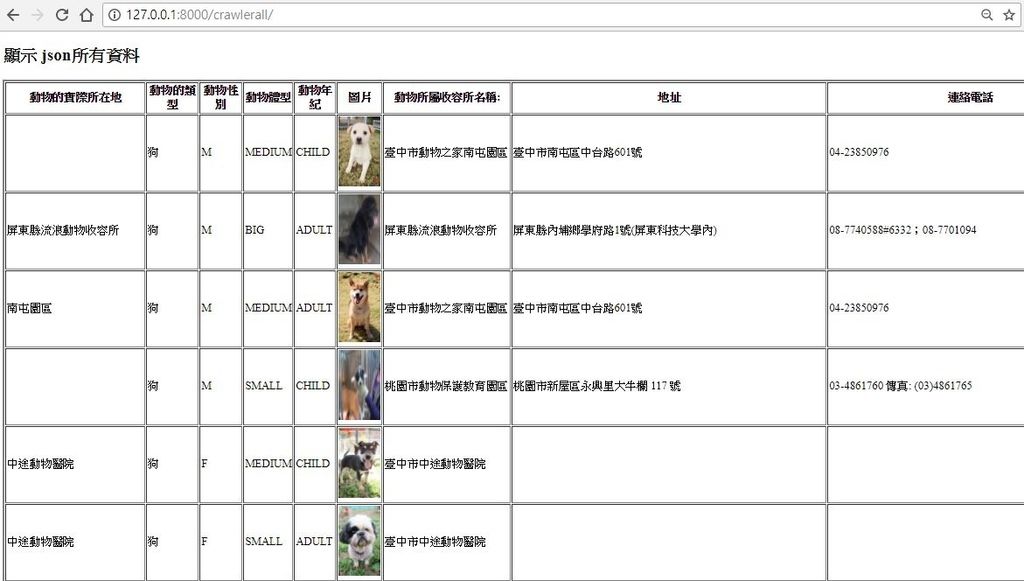
3.分頁顯示多筆資料
在 <views.py> 中建立一個名為 crawlerpage 的自訂函數
同 學習紀錄(八) 這裡將進行分頁顯示,避免網頁資料太多爬取過久
跟之前不同的地方是,這裡是分析 json 資料來做分頁
建立一個名為 jd2 的變數,把分析好的 jd 分成10筆資料,再將 jd2 傳到前台顯示
page1 = 1
def crawlerpage(request,pageindex=None):
global page1
res = requests.get('http://data.coa.gov.tw/Service/OpenData/AnimalOpenData.aspx')
ress = res.text
jd = json.loads(ress)
animal_place=[]
for item in jd:
animal_place.append(item['animal_place'])
datasize = len(animal_place) #資料筆數
pagesize = 10 #每頁資料筆數
totpage = math.ceil(datasize / pagesize)
if pageindex == None: #無參數
page1 = 1
jd2 = jd[:pagesize] #取前10筆
elif pageindex =='1': #上一頁
start = (page1-2)*pagesize #該頁的第1筆資料
if start >=0: #有前頁資料就顯示
jd2 = jd[start:(start+pagesize)]
page1 -= 1
elif pageindex == '2': #下一頁
start = page1*pagesize
if start < datasize: #有下頁資料就顯示
jd2 = jd[start:start+pagesize]
page1 = page1 + 1
elif pageindex == '3': #由詳細頁面返回首頁
start = (page1-1)*pagesize #取得原有頁面第1筆資料
jd2 = jd[start:start+pagesize]
currentpage = page1
return render(request,"crawlerpage.html",locals())
創建一個名為 <crawlerpage.html> 的模版
這邊新增了顯示當前頁數的訊息
<!DOCTYPE html>
<html>
<head>
<meta charset="utf-8">
<title>分頁顯示 json 所有資料</title>
</head>
<body>
<h2>分頁顯示 json 所有資料</h2>
<table border="3" cellpadding="2" cellspacing="2">
<th>動物的實際所在地</th>
<th>動物的類型</th>
<th>動物性別</th>
<th>動物體型</th>
<th>動物年紀</th>
<th>圖片</th>
<th>動物所屬收容所名稱:</th>
<th>地址</th>
<th>連絡電話</th>
{% for i in jd2 %} <!-- #jd2為json所有資料 i則是現在建立用來遞迴的變數 -->
<tr>
<td>{{i.animal_place}}</td> <!-- #Django Template 語言 使用'.' 來顯示子項目 -->
<td>{{i.animal_kind}}</td>
<td>{{i.animal_sex}}</td>
<td>{{i.animal_bodytype}}</td>
<td>{{i.animal_age}}</td>
<td><img src="{{i.album_file}}" width="60" height="100"></td>
<td>{{i.shelter_name}}</td>
<td>{{i.shelter_address}}</td>
<td>{{i.shelter_tel}}</td>
</tr>
{% endfor %}
</table>
<h3><div class="topfunction" align="center">
{% if currentpage > 1 %}
<a href="/crawlerpage/1/" title="上一頁">上一頁</a>
{% endif %}
-當前在第 {{currentpage}} 頁 -
{% if currentpage < totpage %}
<a href="/crawlerpage/2/" title="下一頁">下一頁</a>
{% endif %}
</div></h3>
</body>
</html>
在<urls.py>添加 crawlerpage 的路徑,並到瀏覽器執行:
path('crawlerpage/',views.crawlerpage),
re_path('crawlerpage/(\d+)/$',views.crawlerpage), #要導入 re_path 套件
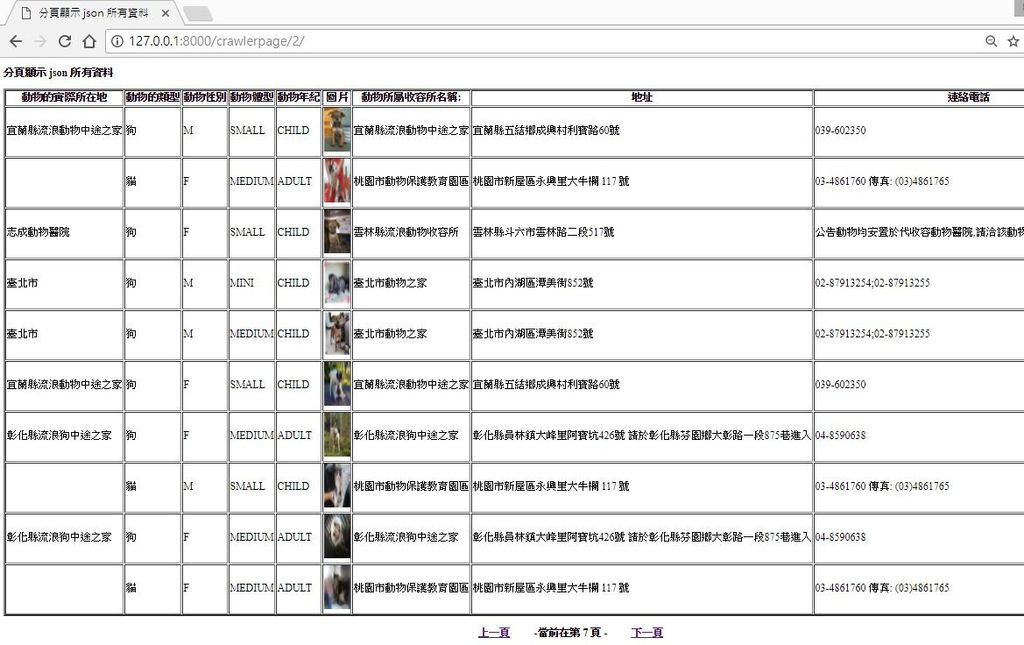
四、分析網頁資料並顯示:
這次以 蘋果日報即時新聞 為範例,先爬取資料,再藉由Django網頁顯示
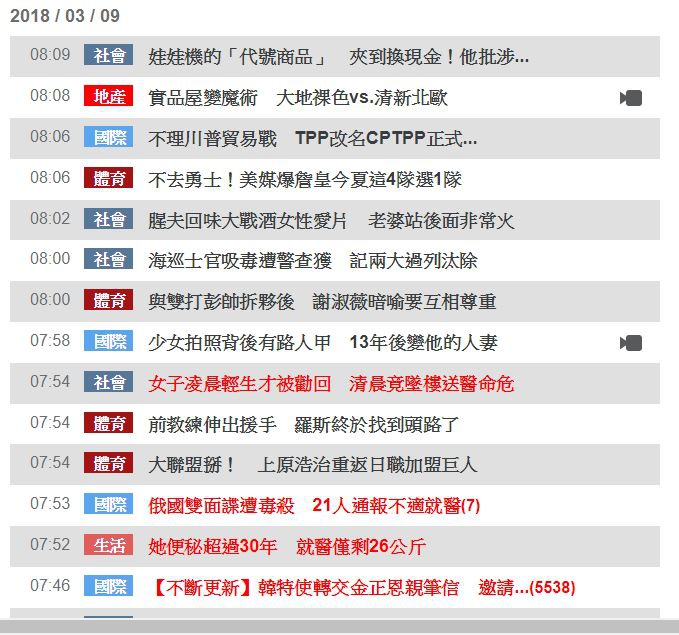
1.分析網頁
以F12檢視網頁,接下來要找到日期、時間、分類、標題、網址 五項資料
日期 在 <h1 class="dddd">標籤
時間 在 <ul class="rtddd slvl">標籤 底下的 <time>
分類 在 <ul class="rtddd slvl">標籤 底下的 <h2>
標題 在 <ul class="rtddd slvl">標籤 底下的 <h1>
網址 在 <ul class="rtddd slvl">標籤 底下的 <a href>
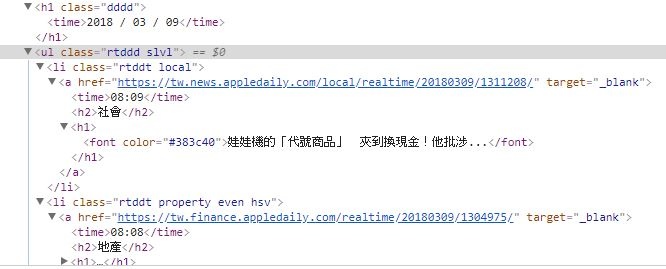
在 <views.py> 中建立一個名為 newscrawler 的自訂函數
接著爬蟲程式將依照以下步驟撰寫:
- 導入爬蟲需要用到的套件
- 連接網址
- 擷取網頁資料
- 建立空串列
- 將元素添加入串列
- 使用zip()函式集合串列
from bs4 import BeautifulSoup
import re
import urllib
def newscrawler(request):
url = 'https://tw.appledaily.com/new/realtime' #選擇網址
user_agent = 'Mozilla/5.0 (Windows; U; Windows NT 6.1; zh-CN; rv:1.9.2.15) Gecko/20110303 Firefox/3.6.15' #偽裝使用者
headers = {'User-Agent':user_agent}
data_res = urllib.request.Request(url=url,headers=headers)
data = urllib.request.urlopen(data_res)
data = data.read().decode('utf-8')
sp = BeautifulSoup(data, "html.parser")
#當日日期
date = sp.find("h1",{"class":"dddd"})
print(date.text)
#每筆資料的時間
time= []
times = sp.find("ul",{"class":"rtddd slvl"}).findAll("time")
for time1 in times:
time.append(time1.text)
#分類
category=[]
categorys = sp.find("ul",{"class":"rtddd slvl"}).findAll("h2")
for category1 in categorys:
category.append(category1.text)
#標題
title=[]
titles = sp.find("ul",{"class":"rtddd slvl"}).findAll("h1")
for title1 in titles:
title.append(title1.text)
#網址
link=[]
links = sp.find("ul",{"class":"rtddd slvl"}).findAll("a",href = re.compile('appledaily'))
for link1 in links:
link.append(link1['href'])
all = zip(time,category,title,link)
return render(request,"newscrawler.html",locals())
創建一個名為 <newscrawler.html> 的模版
<!DOCTYPE html>
<html>
<head>
<meta charset="utf-8">
<title>蘋果日報 即時新聞</title>
</head>
<body>
<h2>顯示 蘋果日報 即時新聞 {{date}}</h2>
<table border="3" cellpadding="2" cellspacing="2">
<th>時間</th>
<th>分類</th>
<th>標題</th>
<th>網址</th>
{% for time,category,title,link in all %} <!-- 使用zip將串列集合後即可同時調用 -->
<tr>
<td>{{time}}</td>
<td>{{category}}</td>
<td><a Target="_blank" href="{{link}}">{{title}}</td> <!-- 以新視窗開啟連結 -->
<td>{{link}}</td>
</tr>
{% endfor %}
</table>
</body>
</html>
在<urls.py>添加 newscrawler 的路徑,並到瀏覽器執行:
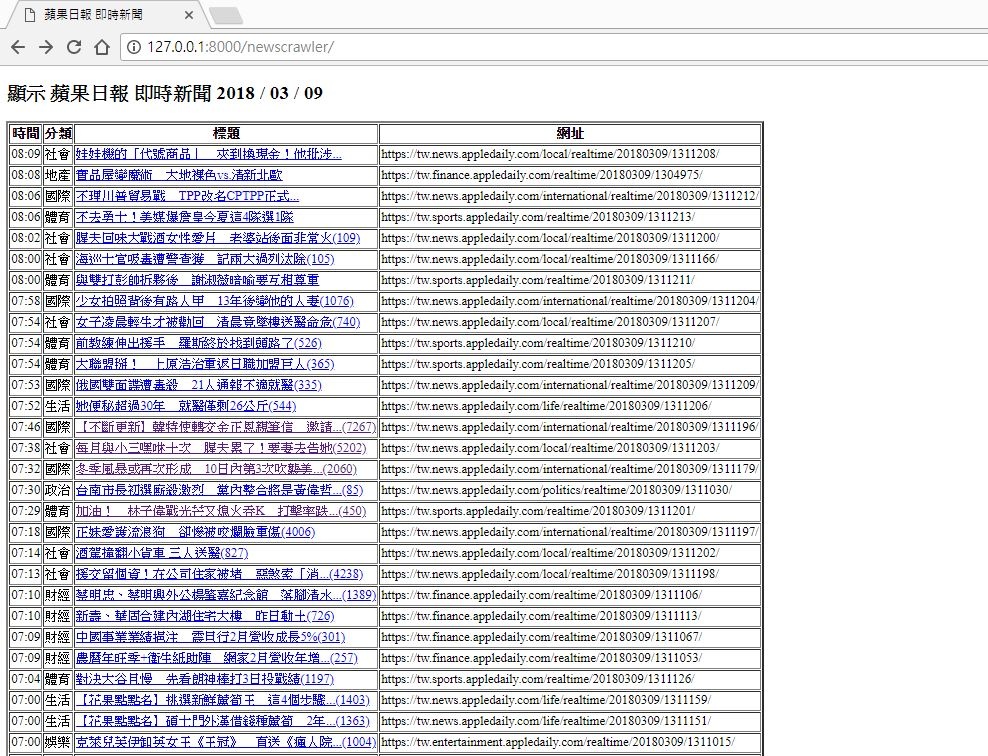
3.分頁顯示多筆資料
在 <views.py> 中建立一個名為 newspage 的自訂函數
同 學習紀錄(八) 這裡將進行分頁顯示,避免網頁資料太多爬取過久
跟之前不同的地方是,這裡是要將網路爬蟲的多個 List 加入一個 zip
再把zip 放入一個名為 listall 的 list ,
而裡面的元素則改為 時間:listall[0] 、分類:listall[1] 、標題:listall[2] 、網址:listall[3]、
建立一個名為listall2 的變數,把分析好的 listall 分成6筆資料,再將 listall2 傳到前台顯示
page2 = 1
def newspage(request,pageindex2=None): #蘋果日報即時新聞爬蟲
url = 'https://tw.appledaily.com/new/realtime' #選擇網址
user_agent = 'Mozilla/5.0 (Windows; U; Windows NT 6.1; zh-CN; rv:1.9.2.15) Gecko/20110303 Firefox/3.6.15' #偽裝使用者
headers = {'User-Agent':user_agent}
data_res = urllib.request.Request(url=url,headers=headers)
data = urllib.request.urlopen(data_res)
data = data.read().decode('utf-8')
sp = BeautifulSoup(data, "html.parser")
#當日日期
dated = sp.find("h1",{"class":"dddd"})
date = dated.text
#每筆資料的時間
time= []
times = sp.find("ul",{"class":"rtddd slvl"}).findAll("time")
for time1 in times:
time.append(time1.text)
#分類
category=[]
categorys = sp.find("ul",{"class":"rtddd slvl"}).findAll("h2")
for category1 in categorys:
category.append(category1.text)
#標題
title=[]
titles = sp.find("ul",{"class":"rtddd slvl"}).findAll("h1")
for title1 in titles:
title.append(title1.text)
#網址
link=[]
links = sp.find("ul",{"class":"rtddd slvl"}).findAll("a",href = re.compile('appledaily'))
for link1 in links:
link.append(link1['href'])
all = zip(time,category,title,link)
listall = list(all)
global page2
datasize = len(time)
pagesize = 6
totpage = math.ceil(datasize / pagesize)
if pageindex2 == None: #無參數
page2 = 1
listall2 = listall[:pagesize] #取前6筆
elif pageindex2 =='1': #上一頁
start = (page2-2)*pagesize #該頁的第1筆資料
if start >=0: #有前頁資料就顯示
listall2 = listall[start:(start+pagesize)]
page2 -= 1
elif pageindex2 == '2': #下一頁
start = page2*pagesize
if start < datasize: #有下頁資料就顯示
listall2 = listall[start:start+pagesize]
page2 = page2 + 1
elif pageindex2 == '3': #由詳細頁面返回首頁
start = (page2-1)*pagesize #取得原有頁面第1筆資料
listall2 = listall[start:start+pagesize]
currentpage = page2
return render(request,"newspage.html",locals())
創建一個名為 <newspage.html> 的模版
<!DOCTYPE html>
<html>
<head>
<meta charset="utf-8">
<title>分頁顯示 蘋果日報 即時新聞</title>
</head>
<body>
<h2>分頁顯示 蘋果日報 即時新聞 {{date}}</h2>
<table border="3" cellpadding="2" cellspacing="2">
<th>時間</th>
<th>分類</th>
<th>標題</th>
<th>網址</th>
{% for i in listall2 %}
<tr>
<td>{{i.0}}</td>
<td>{{i.1}}</td>
<td><a Target="_blank" href="{{i.3}}">{{i.2}}</td> <!-- 以新視窗開啟連結 -->
<td>{{i.3}}</td>
</tr>
{% endfor %}
</table>
<h3><div class="topfunction" align="center">
{% if currentpage > 1 %}
<a href="/newspage/1/" title="上一頁">上一頁</a>
{% endif %}
-當前在第 {{currentpage}} 頁 -
{% if currentpage < totpage %}
<a href="/newspage/2/" title="下一頁">下一頁</a>
{% endif %}
</div></h3>
</body>
</html>
在<urls.py>添加 newspage 的路徑,並到瀏覽器執行:
path('newspage/',views.newspage),
re_path('newspage/(\d+)/$',views.newspage),
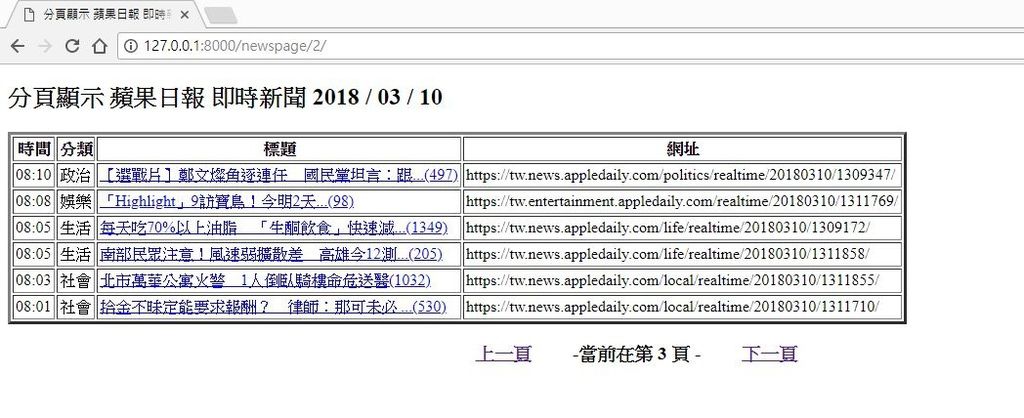


 留言列表
留言列表